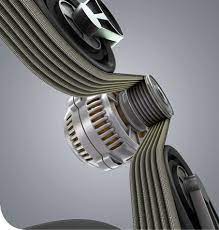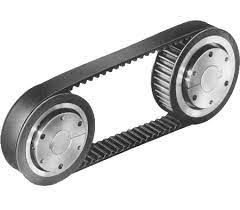Product Description
Quick Details
| Applicable Industries:
Building Material Shops, Manufacturing Plant, Machinery Repair Shops, Food & Beverage Factory, Construction works , Energy & Mining, Other |
Customized support:
OEM, ODM |
| Part name : HTD3m belt pulley | Surface treatment: Blackened/blue |
| Material: C45 | Brand Name:REACHJY |
| Application:power transmission | Inspection: 100% |
| Certification:ISO | Place of Origin:ZheJiang , China |
| Certification: | ISO |
|---|---|
| Pulley Sizes: | Htd3m |
| Manufacturing Process: | Machine |
| Material: | Steel |
| Surface Treatment: | Blackened/Blue |
| Application: | Chemical Industry, Grain Transport, Mining Transport, Power Plant |
| Samples: |
US$ 50/Piece
1 Piece(Min.Order) | |
|---|
| Customization: |
Available
| Customized Request |
|---|

How do drive belt pulleys contribute to the functioning of agricultural equipment?
Drive belt pulleys play a crucial role in the functioning of agricultural equipment. Here’s a detailed explanation of how drive belt pulleys contribute to the operation of agricultural machinery:
1. Power Transmission:
Agricultural equipment, such as tractors, combines, and hay balers, often require the transfer of power from the engine to various components and attachments. Drive belt pulleys are used to transmit power from the engine’s crankshaft or power take-off (PTO) shaft to components like pumps, augers, conveyors, and cutting mechanisms. By connecting the engine to these components, the pulleys enable the transfer of rotational power, allowing the equipment to perform tasks such as harvesting, planting, and material handling.
2. Speed Control and Gear Reduction:
In agricultural machinery, it is essential to control the speed of various components or achieve gear reduction to match specific tasks and conditions. Drive belt pulleys, in combination with different pulley sizes or gear ratios, enable speed control and gear reduction. By adjusting the pulley sizes or using multiple pulleys, operators can modify the rotational speed of driven components, such as the cutting blades or conveyor belts, to optimize performance based on the requirements of the specific agricultural operation.
3. Belt-Driven Mechanisms:
Many agricultural machines utilize belt-driven mechanisms for functions like threshing, baling, or grain separation. Drive belt pulleys are integral components in these mechanisms, providing power transmission and tensioning for the belts. The pulleys ensure that the belts remain properly tensioned, enabling reliable power transfer and maintaining the desired operation of the belt-driven mechanisms in agricultural equipment.
4. Tensioning and Belt Adjustment:
Drive belt pulleys in agricultural equipment facilitate tensioning and adjustment of belts. Proper belt tension is critical for efficient power transmission and preventing slippage. Pulleys with adjustable positions or built-in tensioning mechanisms allow operators to easily adjust belt tension, ensuring optimal performance and preventing premature belt wear or damage. The ability to adjust belt tension is particularly important in agricultural equipment that may encounter variable loads or require periodic maintenance.
5. Implement Compatibility and Versatility:
Drive belt pulleys contribute to the compatibility and versatility of agricultural equipment. With the use of different pulley sizes or configurations, machinery manufacturers can design equipment that accommodates a wide range of implements and attachments. By selecting the appropriate pulley combination, operators can adapt the equipment to perform different tasks, such as switching between high-speed operations, like mowing, and low-speed operations, like tilling. This versatility enhances the efficiency and productivity of agricultural machinery.
6. Noise and Vibration Control:
Drive belt pulleys help control noise and vibrations in agricultural equipment. Well-designed pulleys with proper alignment and balanced operation minimize vibrations and reduce noise generated during equipment operation. This contributes to a quieter and more comfortable working environment for operators, especially during prolonged use of the machinery.
7. Maintenance and Serviceability:
Properly designed drive belt pulleys enhance the maintenance and serviceability of agricultural equipment. Pulleys that are easily accessible, with removable covers or guards, simplify maintenance procedures. This allows for efficient belt replacement, tension adjustment, or component servicing, reducing downtime and ensuring that the equipment remains operational during critical farming seasons.
8. Energy Efficiency:
Efficient power transmission is essential for achieving energy efficiency in agricultural machinery. Drive belt pulleys help optimize power transfer from the engine to the driven components, minimizing energy losses. Properly sized and designed pulleys ensure that power is efficiently delivered to perform agricultural tasks, resulting in reduced fuel consumption and lower operating costs for farmers.
In summary, drive belt pulleys are vital components in agricultural equipment, contributing to power transmission, speed control, belt-driven mechanisms, tensioning, implement compatibility, noise control, maintenance, serviceability, and energy efficiency. Their presence ensures the reliable and efficient operation of agricultural machinery, ultimately improving productivity and supporting the needs of modern farming practices.

How does the size and design of a drive belt pulley affect its performance?
The size and design of a drive belt pulley have a significant impact on its performance in power transmission systems. Here’s a detailed explanation of how the size and design of a drive belt pulley affect its performance:
1. Speed Ratio and Torque:
The size of a drive belt pulley directly affects the speed ratio and torque transmission between the driving and driven components. A larger pulley diameter relative to the driven component’s pulley diameter will result in slower rotational speed but higher torque transfer. Conversely, a smaller pulley diameter will increase the rotational speed but reduce the torque. The selection of the appropriate pulley size ensures that the desired speed and torque requirements are met for efficient power transmission.
2. Belt Tension and Grip:
The size and design of a drive belt pulley play a crucial role in maintaining proper belt tension and grip. A pulley with a larger diameter provides a larger contact area for the belt, resulting in increased tension and improved grip. This helps prevent belt slippage, especially under high loads or during sudden accelerations. Additionally, the pulley design, including the shape and depth of the grooves, affects the belt’s engagement and grip, further influencing the overall performance and reliability of the power transmission system.
3. Speed and Power Output:
The size and design of a drive belt pulley can impact the speed and power output of the driven component. By adjusting the pulley size, the rotational speed of the driven component can be modified. For example, a larger pulley diameter will reduce the speed of the driven component, while a smaller pulley diameter will increase the speed. This allows for customization of the power output to match the specific requirements of the driven component, optimizing its performance within the system.
4. Belt Life and Durability:
The size and design of a drive belt pulley can affect the life and durability of the belt. When a pulley is properly sized and designed, it helps distribute the belt’s load evenly, reducing stress and wear on the belt. A pulley with the correct dimensions and a suitable design minimizes the risk of excessive bending, stretching, or misalignment, which can lead to premature belt failure. By ensuring proper belt alignment and reducing excessive tension, the size and design of the pulley contribute to the longevity and reliability of the belt.
5. System Efficiency:
The size and design of a drive belt pulley impact the overall efficiency of the power transmission system. An appropriately sized pulley reduces friction losses and improves energy transfer between the driving and driven components. By minimizing energy losses due to slippage or misalignment, the system efficiency is enhanced, resulting in improved overall performance, reduced power wastage, and increased fuel efficiency in automotive applications.
6. Noise and Vibration:
The size and design of a drive belt pulley can influence the levels of noise and vibration in the power transmission system. A well-designed pulley with proper dimensions and groove profiles helps to minimize belt slippage and reduce vibrations caused by uneven loading. Additionally, a balanced pulley design reduces potential vibrations that can propagate through the system, resulting in quieter and smoother operation.
7. System Compactness:
The size and design of a drive belt pulley contribute to the overall compactness of the power transmission system. By selecting pulleys with appropriate dimensions, it is possible to optimize the packaging of the system components, allowing for efficient use of space. This is particularly important in applications with limited space, such as automotive engines, where compactness is essential for proper integration and overall vehicle design.
Overall, the size and design of a drive belt pulley have a significant impact on its performance in power transmission systems. Proper sizing and design considerations ensure optimal speed ratio, torque transfer, belt tension, grip, speed and power output, belt life and durability, system efficiency, noise and vibration levels, and system compactness. By carefully selecting and designing drive belt pulleys, efficient and reliable power transmission can be achieved for various applications.

In which industries and applications are drive belt pulleys commonly used?
Drive belt pulleys are widely utilized in various industries and applications due to their versatility and effectiveness in power transmission. Here’s a detailed explanation of the industries and applications where drive belt pulleys are commonly used:
1. Automotive Industry:
Drive belt pulleys are extensively employed in the automotive industry. They are utilized in engines to transfer power from the crankshaft to components such as alternators, water pumps, power steering pumps, air conditioning compressors, and superchargers. These pulleys ensure the proper functioning of vital automotive systems and accessories.
2. Industrial Machinery:
In industrial machinery, drive belt pulleys are utilized in various applications. They are commonly used in conveyor systems to transfer power and enable the movement of materials along production lines. Drive belt pulleys are also employed in manufacturing equipment, agricultural machinery, printing presses, packaging machinery, and many other industrial applications where power transmission is required.
3. HVAC Systems:
In heating, ventilation, and air conditioning (HVAC) systems, drive belt pulleys are utilized to transfer power from electric motors or engines to components such as blowers, fans, and compressors. They help circulate air, control temperature, and maintain proper airflow in residential, commercial, and industrial HVAC systems.
4. Agricultural Equipment:
Agricultural machinery extensively incorporates drive belt pulleys. They are commonly used in tractors, combines, and other agricultural equipment to transfer power from the engine to various components such as grain augers, balers, pumps, and irrigation systems. Drive belt pulleys facilitate the efficient operation of agricultural machinery in planting, harvesting, and crop processing.
5. Fitness Equipment:
Drive belt pulleys are found in fitness equipment such as treadmills, stationary bikes, and weightlifting machines. They are utilized to transfer power from motors or flywheels to rotating components, allowing users to engage in cardiovascular exercises or strength training. Drive belt pulleys ensure smooth and reliable power transmission in fitness equipment.
6. Mining and Construction:
In the mining and construction industries, drive belt pulleys are used in heavy machinery and equipment. They are employed in conveyor systems, crushers, screeners, excavators, and other machinery to transfer power and facilitate material handling, crushing, screening, and excavation operations.
7. Material Handling:
Drive belt pulleys play a crucial role in material handling applications. They are used in warehouse conveyor systems, elevators, escalators, and lifts to transfer power and enable the movement of goods, packages, and people. Drive belt pulleys ensure efficient and reliable transportation in material handling operations.
8. Marine and Marine Equipment:
In the marine industry, drive belt pulleys are employed in various applications. They are used in marine engines to transfer power from the crankshaft to components such as generators, water pumps, and propulsion systems. Drive belt pulleys ensure the smooth operation and performance of marine vessels.
9. Power Generation:
In power generation facilities, drive belt pulleys are commonly used in turbines, generators, and other equipment. They are employed to transfer power from the rotating shafts to generators and other auxiliary components. Drive belt pulleys play a vital role in power generation and distribution.
These are just a few examples of the industries and applications where drive belt pulleys are commonly used. Their versatility, efficiency, and reliability in power transmission make them indispensable components in various mechanical systems across a wide range of industries.


editor by CX
2023-09-30